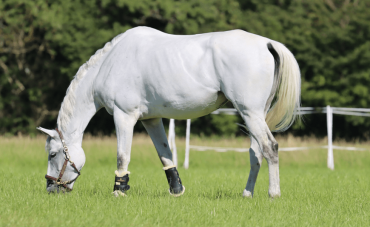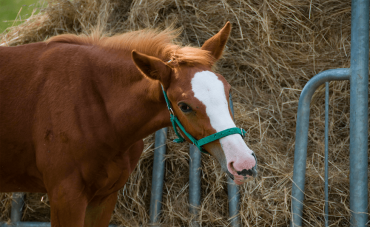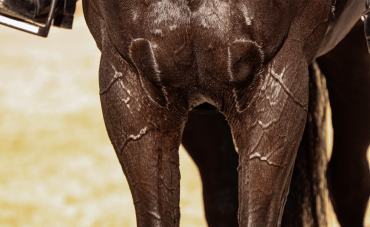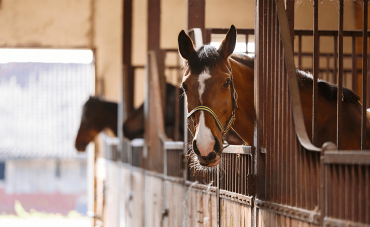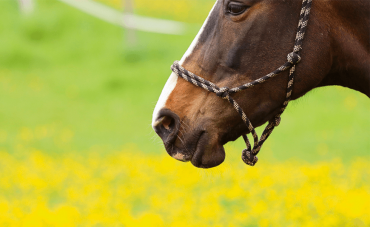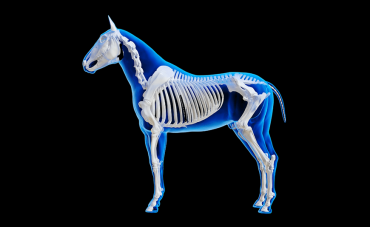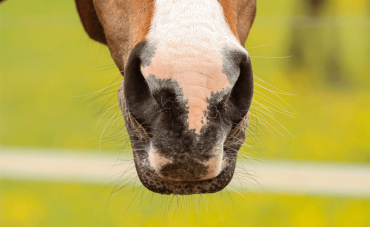Sometimes it's not easy to ascertain whether your horse is in good health. Some issues are more apparent than others. We offer you five straightforward tips to check that your horse is in good health. In case of uncertainty, the best course of action is to contact your vet, who will be able to assess your horse's health.
Even before discussing the vital signs that can be examined during an assessment, it's crucial to observe your horse. Horses are creatures of habit; they have their routines. A change in behaviour, such as a horse appearing more fatigued or, conversely, more agitated than usual, can serve as an initial indicator of a potential health problem.
Temperature is a key indicator of good health.
Your horse's rectal temperature will be an initial sign of its health. It should be measured in the rectum using a conventional thermometer available online and in most stores.
If you're interested in reference values, the normal temperature for an adult horse at rest is considered to be between 37.5°C and 38°C. However, there are slight variations between stallions and mares, with the latter generally having a slightly higher body temperature. In foals, the normal temperature is around 38.5°C.
It's important to note that physiological variations, primarily due to stress or heavy exertion, can cause temperatures to fluctuate by +/- 0.5°C.
A horse is considered to have a fever when its temperature exceeds 38.3°C. Of course, if you take your horse's temperature in the middle of summer or after strenuous exercise, the temperature may reach 38.3°C, which is normal given the circumstances. On the other hand, a horse at rest on a day without excessive heat should have a temperature below 38°C.
Once again, variations in "reference" temperatures can be a sign of a problem, so don't hesitate to contact your vet.
Heart and lung function are indicators of good health.
After measuring your horse's temperature, it can be helpful to quickly check the heart and lungs by assessing the heart rate and respiratory rate.
Heart Rate
The heart rate refers to the number of heart contractions/relaxations in one minute.
In a healthy adult horse, the heart rate is approximately 30 to 40 beats per minute at rest. Note that during exercise, a horse's heart rate can increase to 160 to 250 beats per minute. If a horse is in good health, its heart rate should decrease fairly quickly after strenuous activity.
A resting adult horse with a heart rate above 60 beats per minute is a sign of pain. In foals, the heart rate is higher, with a healthy foal having a heart rate between 50 and 70 beats per minute.
If you don't have a stethoscope to measure your horse's heart rate, don't worry; there are various methods for taking a pulse. You can find it under their neck, at the level of the fetlock, or even under the shoulder muscle. In each case, count the number of beats you feel in one minute.
Breathing Frequency
When discussing the horse's respiratory rate, we refer to the number of inspirations and expirations (breathing cycles) in one minute.
In a healthy adult horse, the respiratory rate is typically 10 to 14 breathing cycles per minute at rest. However, during exercise, the respiratory rate increases to supply the necessary oxygen and nutrients to the body, sometimes exceeding 45 cycles per minute during intense activity.
In foals, the respiratory rate is higher, ranging from 20 to 40 respiratory cycles per minute.
To measure your horse's breathing rate, place your hand in front of their nose and count the number of breaths in one minute. Your horse can only breathe through their nose, so there's no risk of them breathing through their mouth.
In addition to the breathing rate, observe your horse's sides during exhalation. In a healthy horse, the sides should not significantly expand while exhaling. If they do, it indicates that your horse is using its muscles to breathe, which is abnormal, particularly in horses with emphysema.
As with heart rate, an elevated respiratory rate in a resting horse is a sign of respiratory illness or pain.
Hydration
Monitoring your horse's hydration levels is crucial for their well-being. A horse can lose up to 50 litres of water in a few hours, and when dehydrated, they may not have the instinct to drink.
It is therefore especially important to check your horse's hydration, especially after activity. Pinch the skin at the neck when you release the fold, observe how long it takes for the skin to return to its normal state without leaving a mark. If your horse is properly hydrated, the skin should return to its normal position in less than 2 seconds. The longer it takes for the skin to recover, the more severe your horse's dehydration. If the skin does not return to its place after 10 seconds, it's a critical emergency for your horse.
Mucous Membrane Colour
The colour of your horse's mucous membranes is a good indicator of their health. Changes in the colour of the mouth and eye mucous membranes can signal internal issues. To check the mouth's mucous membrane, lift your horse's upper lip and press on the gum with your thumb, then observe the colour. It should be pink, neither too pale nor purple. When you press on the gum, it should blanch but re-colour almost immediately, in less than 2 seconds. This also allows you to assess your horse's hydration and venous return.
For the eye's mucous membrane, press down on the upper eyelid with your index finger and pull down the lower eyelid with your thumb to reveal the lower mucous membrane. Observe the colour, which should be pink to pale pink, but not too pale or red. In addition to indicating general health, the eye's mucous membrane can be an indicator of eye issues.
For the mucous membranes, the colour is critical. In a healthy horse, the mucous membranes should be pale pink. If they appear more red or purplish, it can indicate inflammation and usually a high body temperature. White mucous membranes may signal dehydration, while yellow suggests a potential liver problem.
Droppings and Urine
Droppings and urine are indicators of internal health, so it's worth examining them to gauge your horse's well-being. Healthy horse dung should be formed, slightly moist, and not have a strong odour. If your horse has consistently liquid or abnormally dry droppings, it should raise concern. The absence of droppings for an extended period could signal colic, in which case, you can listen to intestinal sounds by placing your ear to your horse's abdomen. If you don't hear anything or hear minimal sounds, it's advisable to contact your vet promptly and follow colic management practices.
Regarding urine, like mucous membranes, the colour provides information about your horse's health. A healthy horse will have light yellow urine. Lighter urine may indicate kidney failure or diabetes, while more orange-coloured urine could signal dehydration or intoxication. Frequent urination in small quantities may suggest a kidney problem. Red urine can indicate pathologies such as hematuria, piroplasmosis, or certain liver diseases. Similar to droppings, a lack of urine should be a cause for concern.
That concludes our tips for assessing your horse's overall health. If you have any doubts, don't hesitate to contact your veterinarian, who can provide guidance and assistance.

